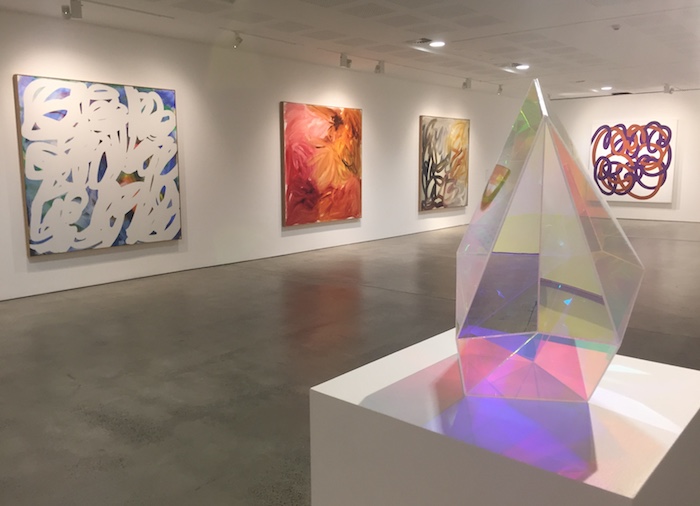Installation view Gemma Smith Rhythm Sequence at UNSW Galleries (2019); photo Artshub
In an art world that today could be described for its embrace of narrative and socially alert storytelling, to walk into an exhibition of abstractions that cause your belly to leap with pure aesthetic joy, feels fresh – renewed.
I am talking about the mid-career survey of Gemma Smith entitled Rhythm Sequence, curated by Dr José Da Silva for UNSW Galleries.
The exhibition traces Smith’s work since 2003, but rather than opting for a chronological hang of the 50-plus works, Da Silva has sequenced the works ‘to emphasise Smith’s playful engagement with ideas of juxtaposition and disjunction, and her enduring interest in the act of painting itself.’
What that means to the viewer is that you have this eloquent play and slide between scale and medium – the eye darts around the space drawing connections and departures, intimacies and grand gestures. What ties it all together is Smith’s 30-year journey with colour.
Heart to it all, is a reminder to experiment and push beyond perceptions. This is perhaps best introduced by the Deep Air (2017) in the gallery foyer, painted on a sheet of starfire glass and floating suspended in space, despite its incredible weight.
The exhibition flows across two exhibition spaces intermittently moving between painting and sculpture. For example, in the first gallery the painting The Well (2008) echoes one of Smith’s brightly coloured aircraft floor-based sculptures from her Adaptables series (2005-08). While a small framed work, Paper 4 (2003) connects with Untitled (2003), if you let your eye drift to the other end of the gallery.

Installation view Gemma Smith Rhythm Sequence at UNSW Galleries (2019); photo Artshub
It’s not a shift in style, but an extension of it that we are witness to. Curator and Writer Julie Ewington says of Smith in the exhibition monograph: ‘She is neither modernist or gestural abstractionist – she is both.’
This first gallery hold three sculptures – the aforementioned modular, folded piece with its crisp geometric edges, which questions how colour makes space. At the other end, Smith takes that form into multi-coloured translucent acrylic sheeting with a pair of sculptures from her Boulders series (pictured top).
As the light moves through these polyhedrons colour becomes an active agent, cast and refracted. It is this other element – the unknown – harnessed and released simultaneously that has driven Smith’s desire to experiment so broadly across her oeuvre.
They sit alongside a suite of small boards, that bounce in contrast to the larger paintings around the room – Crushing (2017), Way (2010), Furill (2014), and the brushy pale painting Skew (2017).
Curator Ellie Buttrose described Smith’s larger paintings as being ‘authentically gestural in that they trace Smith’s “painter’s reach” across large canvases scaled precisely to her body.’
Walking through this exhibition you can’t help but feel that bodily connection.
The tone continues in the second gallery with a movement between Smith’s Tangle Paintings (2009-13) with their fat looping brushstrokes laid over a found grounds, to her Chessboard paintings from 2007 that emphasis the play of formations, and also working with a found surface, to a wall-based prism work, and later more minimal works, a painting using an Interference pigment and dichroic acrylic sculpture.
All question placement and movement within a composition.

Installation view Gemma Smith Rhythm Sequence at UNSW Galleries (2019); photo Artshub
But why this intricate description of Da Silva’s hang? While Smith’s paintings may give the impression of the quick gesture or plotted geometry, it demonstrates that one has to be remember confidence only comes from years of committed practice.
These are calculated moves – systematic – and always compositional in their approach, considering weight, degree of angles, volume and the spatial quality of colour. Smith’s paintings encourage our eye to keep moving, to keep questioning.
Rhythm Sequence also demonstrates the value of a survey exhibition, to look across an artist’s career and map the consistency of thinking, of experimenting and extending their practice.
Many of these works have been exhibited for the first time, largely purchase by private collectors at the time of making and showing. This is perhaps one of the pitfalls for a successful artist; it is rare to see a breadth of their career in a museum environment.
Da Silva, said: ‘The exhibition marks the first in a new series of mid-career surveys by influential Australian artists and designers – a commitment that aims to provide audiences with a deeper appreciation of contemporary practice in Australia.’
The university gallery will tour the exhibition to Brisbane, again extended that agenda to carve our legacy exhibitions for artists working in our times.
The exhibition is accompanied by a stunning monograph Found Ground 2018, published by Formist Editions.
4 ½ stars ★★★★☆
Gemma Smith: Rhythm Sequence
15 March – 1 June 2019
UNSW Galleries
Rhythm Sequence will be presented by QUT Art Museum from 17 August – 27 October
Gemma Smith is represented by Sarah Cottier Gallery, Sydney and Milani Gallery, Brisbane





